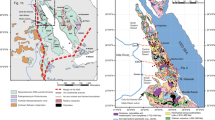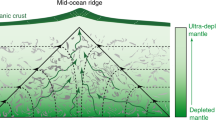Abstract
The hypothesis that mantle plumes contain recycled oceanic crust1 is now widely accepted. Some specific source components of the Hawaiian plume have been inferred to represent recycled oceanic basalts2, pelagic sediments3,4 or oceanic gabbros5. Bulk lava compositions, however, retain the specific trace-element fingerprint of the original crustal component in only a highly attenuated form. Here we report the discovery of exotic, strontium-enriched melt inclusions in Mauna Loa olivines. Their complete trace-element patterns strongly resemble those of layered gabbros found in ophiolites, which are characterized by cumulus plagioclase with very high strontium abundances6. The major-element compositions of these melts indicate that their composition cannot be the result of the assimilation of present-day oceanic crust through which the melts have travelled. Instead, the gabbro has been transformed into a (high-pressure) eclogite by subduction and recycling, and this eclogite has then been incorporated into the Hawaiian mantle plume. The trace-element signature of the original plagioclase is present only as a ‘ghost’ signature, which permits specific identification of the recycled rock type. The ‘ghost plagioclase’ trace-element signature demonstrates that the former gabbro can retain much of its original chemical identity through the convective cycle without completely mixing with other portions of the former oceanic crust.
This is a preview of subscription content, access via your institution
Access options
Subscribe to this journal
Receive 51 print issues and online access
$199.00 per year
only $3.90 per issue
Buy this article
- Purchase on Springer Link
- Instant access to full article PDF
Prices may be subject to local taxes which are calculated during checkout




Similar content being viewed by others
References
Hofmann,A. W. & White,W. M. Mantle plumes from ancient oceanic crust. Earth Planet. Sci. Lett. 57, 421– 436 (1982).
Lassiter,J. C. & Hauri,E. H. Osmium-isotope variations in Hawaiian lavas: Evidence for recycled oceanic lithosphere in the Hawaiian plume. Earth Planet. Sci. Lett. 164, 483– 496 (1998).
Hauri,E. H. Major element variability in the Hawaiian mantle plume. Nature 382, 415–419 ( 1996).
Blichert-Toft,J., Frey,F. A. & Albarede, F. Hf isotope evidence for pelagic sediments in the source of Hawaiian basalts. Science 285, 879– 882 (1999).
Hofmann,A. W. & Jochum,K. P. Source characteristics derived from very incompatible trace elements in Mauna Loa and Mauna Kea basalts, Hawaiian Scientific Drilling Project. J. Geophys. Res. 101, 11831–11839 (1996).
Zimmer,M., Kröner,A., Jochum,K. P., Reischmann,T. & Todt,W. The Gabal Gerf complex: A Precambrian N-MORB ophiolite in the Nubian Shield, NE Africa. Chem. Geol. 123, 29–51 (1995).
Danyushevsky,L. V. The effect of small amounts of H2O on fractionation of mid-ocean ridge magmas. Eos 79 (suppl.), S375 (1998).
Rhodes,J. M. & Hart,S. R. in Mauna Loa Revealed: Structure, Composition, History And Hazards (eds Rhodes, J. M. & Lockwood, J. P.) 263–288 (Geophysical Monograph No. 92, American Geophysical Union, Washington, DC, 1995).
Sobolev,A. V. & Shimizu,N. Ultra-depleted primary melt included in an olivine from the Mid-Atlantic Ridge. Nature 363 , 151–154 (1993).
Sobolev,A. V. Melt inclusions in minerals as a source of principal petrological information. Petrology 4, 209–220 (1996).
Gurenko,A. A. & Chaussidon,M. Enriched and depleted primitive melts included in olivine from Icelandic tholeiites - origin by continuous melting of a single mantle column. Geochim. Cosmochim. Acta 59, 2905–2917 (1995).
Kamenetsky,V. S. et al. Calcic melt inclusions in primitive olivine at 43 degrees N MAR: evidence for melt-rock reaction/melting involving clinopyroxene-rich lithologies during MORB generation. Earth Planet. Sci. Lett. 160, 115–132 (1998).
Sobolev,A. V. & Nikogosian,I. K. Petrology of long-lived mantle plume magmatism: Hawaii (Pacific) and Reunion Island (Indian Ocean). Petrology 2, 111–144 ( 1994).
Veksler,I. V., Petibon,C., Jenner,G. A., Dorfman,A. M. & Dingwell, D. B. Trace element partitioning in immiscible silicate-carbonate liquid systems: an initial experimental study using a centrifuge autoclave. J. Petrol. 39, 2095–2104 (1998).
Christensen,U. R. & Hofmann,A. W. Segregation of subducted oceanic crust in the convecting mantle. J. Geophys. Res. 99, 19867–19884 ( 1994).
Allègre,C. J. & Turcotte,D. L. Implications of a two-component marble-cake mantle. Nature 323, 123–127 (1986).
Sobolev,S. V. & Babeyko,A. Y. Modeling of mineralogical composition, density and elastic-wave velocities in anhydrous magmatic rocks. Surv. Geophys. 15, 515–544 (1994).
Snyder,G. A. et al. The origins of Yakutian eclogite xenoliths. J. Petrol. 38, 85–113 ( 1997).
Yasuda,A., Fujii,T. & Kurita,K. Melting phase relations of an anhydrous mid-ocean ridge basalt from 3 to 20 GPa: Implications for the behavior of subducted oceanic crust in the mantle. J. Geophys. Res. 99, 9401– 9414 (1994).
Yaxley,G. M. & Green,D. H. Reactions between eclogite and peridotite: mantle refertilisation by subduction of oceanic crust. Schweiz. Mineral. Petrogr. Mitt. 78, 243–255 (1998).
Eiler,J. M., Farley,K. A., Valley,J. W., Hofmann,A. W. & Stolper,E. M. Oxygen isotope constraints on the sources of Hawaiian volcanism. Earth Planet. Sci. Lett. 144, 453–468 (1996).
Stakes,D. S. & Taylor,H. P. The northern Samail ophiolite - an oxygen isotope, microprobe, and field-study. J. Geophys. Res. B 97, 7043–7080 ( 1992).
Hart,S. R., Blusztajn,J., Dick,H. J. B., Meyer,P. S. & Muehlenbachs,K. The fingerprint of seawater circulation in a 500-meter section of ocean crust gabbros. Geochim. Cosmochim. Acta 63, 4059–4080 (1999).
Hart,S. R. Equilibration during mantle melting - a fractal tree model. Proc. Natl Acad. Sci. USA 90, 11914–11918 (1993).
Rhodes,J. M. Geochemistry of the 1984 Mauna Loa eruption - implications for magma storage and supply. J. Geophys. Res. B 93, 4453– 4466 (1988).
Stolper,E. M., DePaolo,D. J. & Thomas, D. M. Introduction to special section: Hawaii Scientific Drilling Project. J. Geophys. Res. 101, 11593–11598 (1996).
Sharp,W. D., Turrin,B. D., Renne,P. R. & Lanphere,M. A. The 40Ar/39Ar and K/Ar dating of lavas from the Hilo 1-km core hole, Hawaii Scientific Drilling Project. J. Geophys. Res. 101, 11607–11616 (1996).
Roedder,E. Fluid inclusions. Rev. Mineral 12, 1– 644 (1984).
Danyushevsky L. V., Della-Pasqua,F. N. & Sokolov, S. Re-equilibration of melt inclusions trapped by magnesian olivine phenocrysts from subduction-related magmas: petrological implication. Contrib. Mineral. Petrol. 138, 68– 83 (2000).
Hofmann,A. W. Chemical differentiation of the Earth: the relationship between mantle, continental crust, and oceanic crust. Earth Planet. Sci. Lett. 90, 297–314 (1988).
Garcia,M. O. Petrography, olivine and glass chemistry of lavas from the Hawaii Scientific Drilling Project. J. Geophys. Res. 101, 11701–11713 (1996).
Acknowledgements
We thank the HSDP team for providing samples. We thank S. Simakin for ion probe analyses of inclusions; L.V. Danyushevsky for the access to PETROLOG thermodynamic modelling software; S.V. Sobolev for modelling phase compositions at high T-P; P. Kelemen for providing unpublished data on Oman Gabbro; E. Macsenaere-Riester for help with the electron microprobe analyses; F. Künstler for preparing doubly polished sections; and F. Frey, J. Eiler, L.V. Danuyshevsky, V. S. Kamenetsky, A. A. Gurenko and S. R. Hart for comments that helped to improve the clarity of the manuscript. This work was supported by Deutsche Forschungsgemeinschaft and the Russian Foundation of Basic Research (A.V.S. and I.K.N.) and an Alexander von Humboldt award (A.V.S.).
Author information
Authors and Affiliations
Corresponding author
Supplementary information
Rights and permissions
About this article
Cite this article
Sobolev, A., Hofmann, A. & Nikogosian, I. Recycled oceanic crust observed in ‘ghost plagioclase’ within the source of Mauna Loa lavas. Nature 404, 986–990 (2000). https://doi.org/10.1038/35010098
Received:
Accepted:
Issue Date:
DOI: https://doi.org/10.1038/35010098
This article is cited by
-
Evidence of ghost plagioclase signature induced by kinetic fractionation of europium in the Earth’s mantle
Nature Communications (2023)
-
Early Paleoproterozoic Post-Collisional Basaltic Magmatism in Quanji Massif: Implications for Precambrian Plate Tectonic Regime in NW China
Journal of Earth Science (2022)
-
Serial interaction of primitive magmas with felsic and mafic crust recorded by gabbroic dikes from the Antarctic extension of the Karoo large igneous province
Contributions to Mineralogy and Petrology (2021)
-
Oxygen isotope compositions of lavas from the Galapagos archipelago: geochemical contributions from modern crustal sources
Contributions to Mineralogy and Petrology (2019)
-
The effect of liquid composition on the partitioning of Ni between olivine and silicate melt
Contributions to Mineralogy and Petrology (2017)
Comments
By submitting a comment you agree to abide by our Terms and Community Guidelines. If you find something abusive or that does not comply with our terms or guidelines please flag it as inappropriate.



